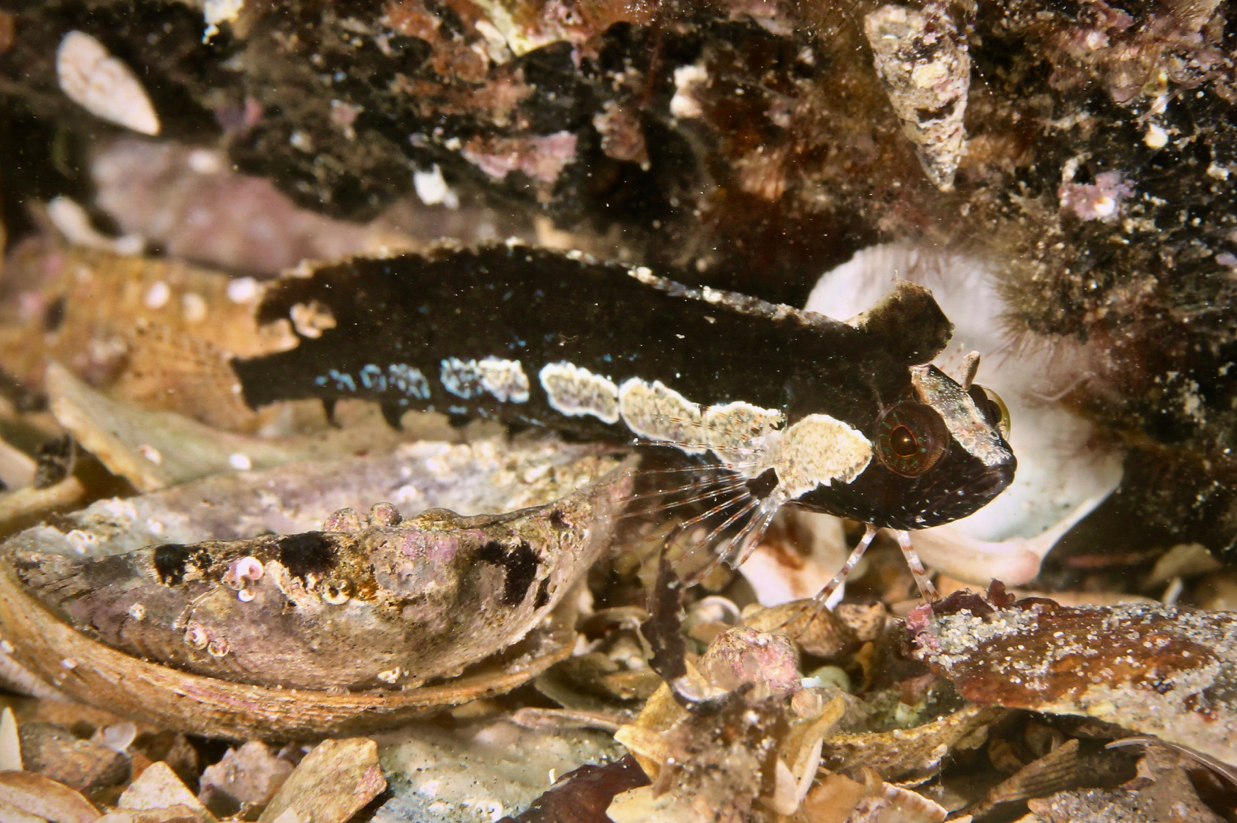Kuiters Weedfish, Heteroclinus kuiteri Hoese & Rennis 2006

Kuiter's Weedfish, Heteroclinus kuiteri, Blairgowrie Pier, Port Phillip, Victoria, March 2017. Source: Rebecca Lloyd / iNaturalist.org. License: CC by Attribution-NonCommercial
A variably-coloured weedfish ranging from uniform brown to distinctly patterned: often dark brown above with a broad brown and white mottled midlateral stripe extending from behind the eye, breaking into oblong patches on tail, sometimes with 8 dark-brown irregular vertical bars on body, often a white snout and top of head, and usually a large dark basal spot on the pectoral fin.
Kuiter's Weedfish has a simple orbital tentacle, and a very tall first dorsal that originates over or just behind the rear margin of the eye.
Kuiters Weedfish, Heteroclinus kuiteri Hoese & Rennis 2006
More Info
|
Distribution |
Endemic to southern Australia from Bitangabee Bay, New South Wales, to Cosy Corner near Albany, Western Australia, and eastern and western Tasmania. Inhabits shelly areas and shallow algal covered reefs. |
|
Features |
Dorsal fin III, XXIX-XXXI, 2-4; Anal fin II, 21-24; Caudal fin (segmented) 10-11; Pectoral fin 12-13; Pelvic fin I, 2 ; lateral line (arched section) 19-25 + (straight section) 0-15; Gill rakers 1-2 + 5-7 = 6-9. Body long, slender, strongly compressed; first dorsal fin tall, with 2-4 segmented rays, arising over or just before hind margin of eye; pores around eye in a single series; pelvic fins with a small spine and 2 segmented rays (3rd ray tiny, hidden in skin); anal fin broadly connected by a membrane to about the middle of tail base; orbital tentacle short, simple. |
|
Feeding |
Colour variable. Sometimes with head, tail, and dorsal portion of trunk dark with a brown and white mottled midlateral band extending posteriorly from eye across upper half of preoperculum and operculum, along trunk, and breaking into oblong patches on tail; females and some males brown with 8 dark-brown irregularly shaped vertical bars across trunk and tail extending onto dorsal and anal fi ns, bars often broken forming irregular saddle-shaped spots, those along back darkest; some males and females with body uniform brown or lightly mottled; 1st dorsal fi n black; females with 1st spine sometimes banded; caudal and ventral fi ns pale, usually with a series of red spots forming transverse bands; snout and edges of interorbital frequently white; lower half of head with large black spots, large dark spot often present basally on pectoral rays 8–l0; females with belly, ventral portions of tail and midlateral portions of trunk and tail sometimes with white spots (Hoese & Rennis 2006). |
|
Similar Species |
Heteroclinus kuiteri is most similar to H. adelaidae and H. macrophthalmus, in having the last anal-fin ray broadly connected by a membrane to the caudal peduncle, two slender and elongate pelvic-fin rays and often a rudimentary third pelvic-fin ray, visible only upon dissection. H. kuiteri differs from H. macrophthalmus in lacking free filaments extending off the first few dorsal spines (free and branched in H. macrophthalmus), in having simple orbital tentacle (versus tentacle branched with five lobes) and fewer dorsal-fin rays (two–four, versus usually five). Heteroclinus kuiteri differs from H. adelaidae in having more numerous pectoral-fin rays 12–13 (versus usually 11), the dorsal-fin origin over or before posterior margin of eye (versus over posterior preopercular margin in H. adelaidae), with pterygiophores in groove in skull (versus pterygiophores behind skull) and no black line along anterior lateral line (versus usually present). |
|
Etymology |
The species is named for Rudie Kuiter, who provided much of the type material and valuable material of other Australian clinids. |
|
Species Citation |
Heteroclinus kuiteri Hoese & Rennis, 2006, Mem. Mus. Vict. 63(1): 21, figs 1-3. Type locality: Portsea Pier, Port Phillip Bay, Victoria. |
|
Author |
Bray, D.J. 2021 |
|
Resources |
Kuiters Weedfish, Heteroclinus kuiteri Hoese & Rennis 2006
References
Hoese, D.F., Gomon, M.F. & Rennis, D.S. 2008. Family Clinidae. pp. 696-722 in Gomon. M.F., Bray, D.J. & Kuiter, R.H (eds). Fishes of Australia's Southern Coast. Sydney : Reed New Holland 928 pp.
Hoese, D.F. & Rennis, D.S. 2006. Description of a new species of Heteroclinus (Blennoidei: Clinidae) from southern Australia. Memoirs of Museum Victoria 63(1): 21-24. DOI http://doi.org/10.24199/j.mmv.2006.63.4 open access
Hutchins, J.B. 1994. A survey of the nearshore reef fish fauna of Western Australia's west and south coasts — The Leeuwin Province. Records of the Western Australian Museum, Supplement 46: 1-66 figs 1-6 (as Heteroclinus species 2)
Rennis, D., Hoese, D.F. & Gomon, M.F. 1994. Family Clinidae. pp. 741-775, figs 650-684B in Gomon, M.F., Glover, C.J.M. & Kuiter, R.H. (eds). The Fishes of Australia's South Coast. Adelaide : State Printer 992 pp. 810 figs. (as Heteroclinus sp 1)
Williams, J.T., Holleman, W. & Clements, K.D. 2014. Heteroclinus kuiteri. The IUCN Red List of Threatened Species 2014: e.T178899A1545332. http://dx.doi.org/10.2305/IUCN.UK.2014-3.RLTS.T178899A1545332.en. Downloaded on 17 August 2016.



